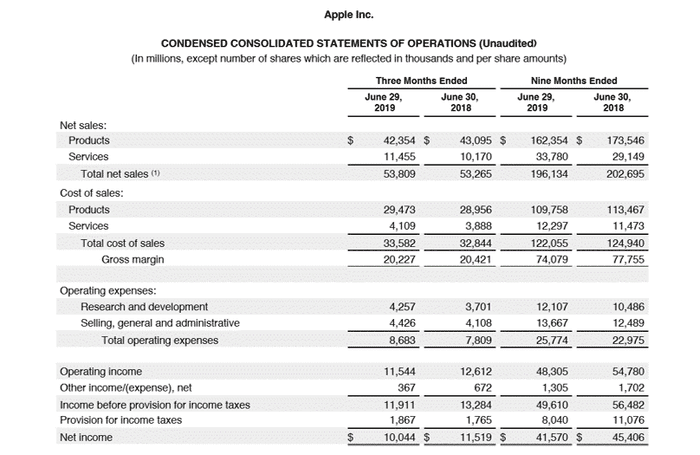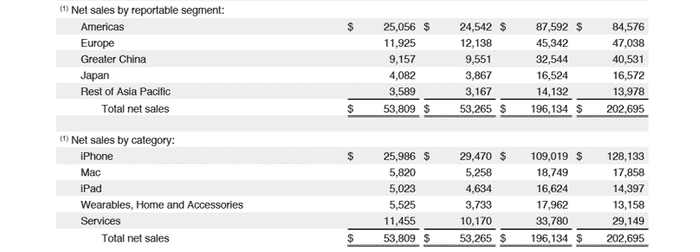Apple and Samsung both had a mixed second quarter
While Apple registered modest growth, with the strong performance of Services compensating the declining iPhone sales, Samsung’s revenue and profit continued to plummet, thanks to weakness in the semiconductor market.
July 31, 2019

While Apple registered modest growth, with the strong performance of Services compensating the declining iPhone sales, Samsung’s revenue and profit continued to plummet, thanks to weakness in the semiconductor market.
Apple’s Q2 2019 results (its financial Q3 2019) were respectable, if not exciting. The total sales went up by 1% to $53.8 billion from $53.3 billion a year ago, therefore making it the company’s record June quarter in terms of revenue. Gross margin slightly declined from 38.3% to 37.6%, and the operating margin dropped from 23.7% to 21.5%.
The iPhone contributed almost $26 billion, a decline of 12% from $29.5 billion the same quarter in 2018. This represented the first quarter when the iPhone accounts less than half of the total revenues since 2012. Notably, the iPhone is the only product category that reported year-on-year decline this quarter, with growth reported in Mac (+10.7%), iPad (+8.4%), Wearables, Home and Accessorie (+48%), and Services (12.6%). The $11.5 billion revenue generated by Services now accounts for 21.3% of the company’s total income.
“These results are promising across all our geographic segments, and we’re confident about what’s ahead,” said Tim Cook, the CEO. “The balance of calendar 2019 will be an exciting period, with major launches on all of our platforms, new services and several new products.”
If by “promising” Cook meant decelerated decline, he was right. Apple’s revenues continued to drop in Europe (-1.8%) and Greater China (-4.1%), the second and third largest markets after the Americas, albeit at a slower pace. Greater China would have registered a growth on constant currency, Cook insisted.
When it comes to the “balance of calendar 2019”, Apple gave a guidance showing mild improvement in Q3 (its financial Q4). The midpoint guidance points to a 16% growth in revenue, largely similar gross margin (38%), similar operating expenses, implying an improved operating margin of about 24%.
While the iPhone’s shrinking contribution may be expected, the strong performance of Services was encouraging. The company claimed it now had 480 million subscriptions across all its service portfolio, and both Apple Pay and the ad income from App Store search delivered triple-digit growth. The 3rd-party subscription revenue generated by the App Store went up by 40%. The Service growth momentum is likely to be further strengthened by the launch of the video streaming service Apple TV+ and the subscription gaming service Apple Arcade in the next quarter. The Services strength helped lift Apple’s share price by 4.2% pre-market.


A few hours later Samsung Electronics announced its less impressive though not surprising Q2 numbers. The company continued to see its profit plummeting by more than half, a trend we have seen in the preceding quarters, and largely in line with the profit warning the company published earlier this month. The total revenues declined by 4% to KRW 56.13 trillion ($47 billion) with the operating profit coming in at KRW6.6 trillion ($5.6 billion), down from KRW14.87 trillion ($13 billion) a year ago, indicating an operating margin of 11.8%, down from 25.4%. The net profit of KRW 5.18 trillion ($4.4 billion) represented a 53% decline from Q2 2018.
Not everything is bleak. IT & Mobile Communications division, Samsung’s largest revenue generator and which includes Samsung’s mobile handset business, reported a 7.8% sales growth although the operating margin declined by 41.5%. The revenue growth was largely driven by the strong sales of the Galaxy A series geared towards the young users. This has helped Samsung gain market share in a contracting smartphone market. On the other hand, the flagship Galaxy S10 series have met “weak sales momentum”, the company conceded. Recently Samsung announced that it has fixed the problem with the Galaxy S10 Fold and is now ready to launch it in “select markets”.
Continued to be worrying is the Display and Semiconductor business division, the biggest profit generator for Samsung. Despite that the display panel business turned profitable after making loss in Q1, weakness in the memory chip segment drove the operating profit down by 71%, on the basis of a revenue decline of 27%, indicating strong price pressure. This has led to the data centre customers to continue to adjust the inventory levels, Samsung claimed.
Another uncertain, though Samsung did not explicitly discuss, is the on-going trade dispute with Japan, which has resulted in trade embargo on the export of selected high-end equipment from a few Japanese companies. This could potentially impact Samsung’s plan to deliver the more advanced semiconductors in the second half of this year. Samsung insisted that it did “see 2H demand recovery” though.
At the time of writing Samsung’s share price was down by 2.6%.

About the Author
You May Also Like


.png?width=300&auto=webp&quality=80&disable=upscale)







.png?width=300&auto=webp&quality=80&disable=upscale)


_1.jpg?width=300&auto=webp&quality=80&disable=upscale)